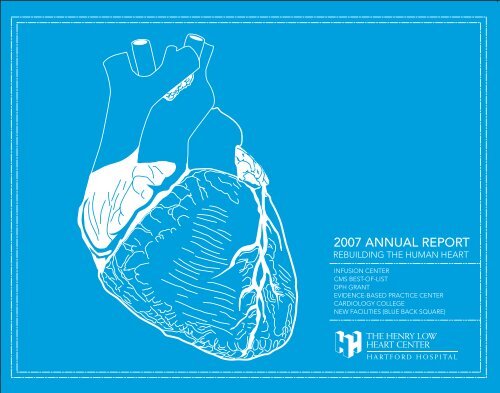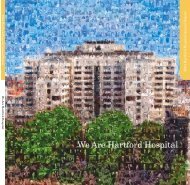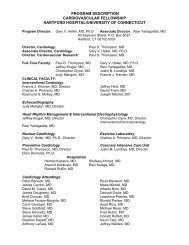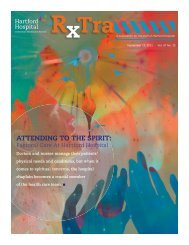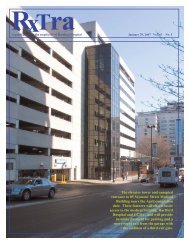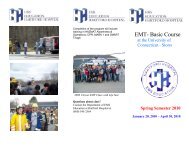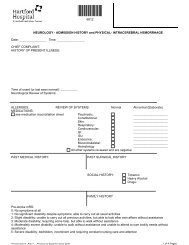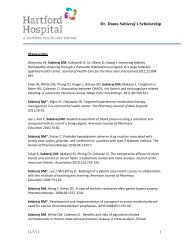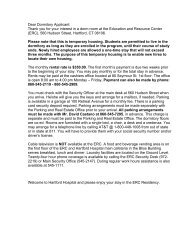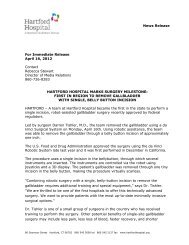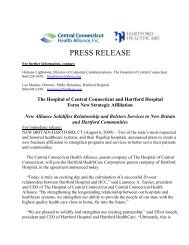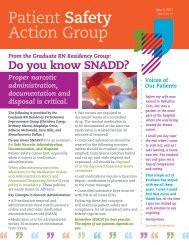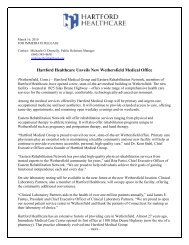Henry Low Heart Center Annual Report, 2007 - Hartford Hospital!
Henry Low Heart Center Annual Report, 2007 - Hartford Hospital!
Henry Low Heart Center Annual Report, 2007 - Hartford Hospital!
Create successful ePaper yourself
Turn your PDF publications into a flip-book with our unique Google optimized e-Paper software.
<strong>2007</strong> ANNUAL REPORT<br />
REBUILDING THE HUMAN HEART<br />
INFUSION CENTER<br />
CMS BEST-OF-LIST<br />
DPH GRANT<br />
EVIDENCE-BASED PRACTICE CENTER<br />
CARDIOLOGY COLLEGE<br />
NEW FACILITIES (BLUE BACK SQUARE)
Contents:<br />
1 Introduction<br />
2 Infusion <strong>Center</strong><br />
3 <strong>Henry</strong> <strong>Low</strong> <strong>Heart</strong> <strong>Center</strong> Retreat<br />
4 CMS Best-Of-List<br />
5 Stop Smoking for Life Receives Grant from DPH<br />
6 High Fashion, with a <strong>Heart</strong><br />
7 Evidence-based Practice <strong>Center</strong><br />
8 New Echocardiography Director<br />
9 <strong>Annual</strong> Cardiovascular Symposium<br />
10 Training Cardiologists of the Future<br />
11 Cardiology College<br />
12 Cardiology at Blue Back Square<br />
13 Cardiologists Listing<br />
14 Research Publications
Introduction<br />
It is with great pleasure that we look back on <strong>2007</strong> to bring you this report from the <strong>Henry</strong> <strong>Low</strong> <strong>Heart</strong> <strong>Center</strong>.<br />
<strong>Hartford</strong> <strong>Hospital</strong>’s heart center had a banner year, attaining recognition from Medicare as one of only 17 US hospitals<br />
whose survival rate after myocardial infarction was better than predicted by risk indicators, attesting to the overall<br />
excellence of <strong>Hartford</strong> <strong>Hospital</strong>’s cardiac care. As Figures 1 and 2 show, <strong>Hartford</strong> <strong>Hospital</strong> exceeds the national<br />
benchmarks for getting patients with heart attacks into lifesaving angioplasty surgery within 90 minutes of hospital arrival<br />
and has lower mortality rates than the national average for patients with non ST elevation acute cardiac events.<br />
Figure 1<br />
ST Elevation MI Door to Balloon Time<br />
October to December <strong>2007</strong><br />
(Percent of patients serviced within 90 minutes)<br />
ST Elevation MI ST Door Elevation to Balloon MI Door Time to - Balloon October Time to December - October to December<br />
Morbidity & Mortality Morbidity for & Non Mortality ST Elevation for Non Acute ST Elevation Cardiac Acute EventsCardiac Events<br />
<strong>2007</strong> (Percent of <strong>2007</strong> patient (Percent serviced of patient within serviced 90 minutes) within 90 minutes)<br />
100.0%<br />
87.5%<br />
75.0%<br />
62.5%<br />
50.0%<br />
100.0%<br />
87.5%<br />
89%<br />
75.0%<br />
62.5%<br />
89%<br />
80%<br />
50.0%<br />
<strong>Hartford</strong> <strong>Hospital</strong><br />
<strong>Hartford</strong> <strong>Hospital</strong><br />
*Benchmark<br />
<strong>Hartford</strong> <strong>Hospital</strong> Average: 69 minutes<br />
<strong>Hartford</strong> <strong>Hospital</strong> <strong>Hartford</strong> Average: <strong>Hospital</strong> 69 minutes Average: 69 minutes<br />
*Benchmark: As tracked by the American College for<br />
Cardiology National *Benchmark: Cardiac As tracked Data by the Registry American Database<br />
*Benchmark: As tracked by the American<br />
College for Cardiology National Cardiac<br />
College for Cardiology National Cardiac<br />
Data Registry Database<br />
Data Registry Database<br />
80%<br />
*Benchmark<br />
5.00%<br />
3.75%<br />
Figure 2<br />
2.50%<br />
1.25%<br />
0%<br />
5.00%<br />
3.75%<br />
2.50%<br />
2.7%<br />
1.25%<br />
Morbidity & Mortality for Non ST<br />
Elevation Acute Cardiac Events<br />
Mortality <strong>2007</strong> Mortality <strong>2007</strong><br />
0%<br />
<strong>Hartford</strong> <strong>Hospital</strong><br />
<strong>Hartford</strong><br />
National <strong>Hospital</strong><br />
Average National<br />
Best Practice Average<br />
<strong>Hospital</strong>s<br />
Best Practice <strong>Hospital</strong>s<br />
In <strong>2007</strong> we were fortunate to recruit two new cardiologists, Detlef Wencker, MD, and David I. Silverman, MD, to lead our<br />
heart failure and echocardiography programs, respectively. The Division’s faculty published more than 60 scientific publications<br />
in peer-reviewed journals and was awarded more than $3.5M in research funds. A variety of community events ranging from<br />
a fashion show to a new consumer education program called Cardiology College were well attended by the public. Many new<br />
services and programs have opened at <strong>Hartford</strong> <strong>Hospital</strong> and our newest satellite location is now opened in West <strong>Hartford</strong><br />
at Blue Back Square. <strong>Hartford</strong> <strong>Hospital</strong> is home to some of the most sophisticated technology available to diagnose and<br />
treat heart disease. We are committed to our patients and grateful to our superb team of medical specialists for their pursuit<br />
of excellence in the delivery of patient care. We hope you will enjoy this <strong>2007</strong> report from the Division of Cardiology.<br />
2.7%<br />
3.9%<br />
3.9%<br />
3.6%<br />
Data Source: ACTION Registry (formerly CRUSADE)<br />
Data Source: ACTION Registry (formerly CRUSADE)<br />
Data Source: ACTION Registry (formerly CRUSADE)<br />
3.6%<br />
The Division of Cardiology Collaborative<br />
Management Team<br />
Paul D. Thompson, MD<br />
Chief of Cardiology<br />
Karen Habig, RN, MS<br />
Nurse Director, Cardiovascular Services<br />
Robert E. Rice, MS<br />
Director, Cardiology Administration<br />
Ellen A. Dornelas, PhD<br />
Director, Cardiology Community Education<br />
and Outreach<br />
Introduction
Infusion <strong>Center</strong> Opens at <strong>Hartford</strong> <strong>Hospital</strong><br />
In January of 2008, <strong>Hartford</strong> <strong>Hospital</strong> opened its state-of-the-art outpatient Infusion <strong>Center</strong> offering specialized care for advanced<br />
heart failure syndrome. As the only center of this kind in the region and as an integral part of the <strong>Heart</strong> Failure and Transplant<br />
<strong>Center</strong> at <strong>Hartford</strong> <strong>Hospital</strong>, this Infusion <strong>Center</strong> provides comprehensive diagnostic and therapeutic services to patients suffering<br />
from acute heart failure exacerbation. Instead of long hospitalizations, heart failure patients can be managed on an outpatient basis<br />
and then returned to the privacy of their homes.<br />
Instead of long hospitalizations, heart failure patients<br />
can be managed on an outpatient basis and then returned<br />
to the privacy of their homes.<br />
The team, led by heart failure expert Detlef Wencker, MD, will provide individualized<br />
management to include intravenous administration of diuretics, vasodilators and other<br />
medications, facilitating rapid recovery from the decompensated heart failure state.<br />
In addition, one-on-one nutritional counseling, social support and skilled nursing care<br />
will help patients better understand and adhere to diet, oral medical therapy and cardiac<br />
rehabilitation. The new outpatient infusion center at <strong>Hartford</strong> <strong>Hospital</strong> is an efficient,<br />
timely and cost-effective approach for patients with acute heart failure syndrome.<br />
It offers highly effective, alternative treatment in a friendly and comfortable outpatient<br />
atmosphere that prevents readmission to the hospital, keeps the patient mobile and<br />
active, which, in turn, translates into better overall cardiovascular outcomes.<br />
Dr. Detlef Wencker<br />
<br />
Infusion <strong>Center</strong>
<strong>Henry</strong> <strong>Low</strong> <strong>Heart</strong> <strong>Center</strong> Retreat<br />
Physicians, nurses and senior leadership from Cardiology<br />
assembled at the <strong>Hartford</strong> Club for a retreat in November<br />
of <strong>2007</strong>. J. Bryan Simmons, Vice President for Planning<br />
and Facilities Development, moderated the retreat and<br />
underscored that <strong>Hartford</strong> <strong>Hospital</strong>’s vision is to be<br />
“the regional destination provider of innovative and<br />
complex care.” Francis Kiernan, MD, Director of the<br />
Catheterization Laboratory, focused on critical steps<br />
that reduce the amount of time needed to diagnose<br />
and treat patients with heart attack. Jeffrey Kluger,<br />
MD, Director of the <strong>Heart</strong> Rhythm Management<br />
<strong>Center</strong>, pointed to the services provided at satellite<br />
sites stretched across Connecticut, in Wallingford,<br />
From left to right: J. Bryan Simmons; Dr. <strong>Henry</strong> <strong>Low</strong>; Dr. Francis Kiernan<br />
New Milford, Torrington, Avon, Glastonbury, West <strong>Hartford</strong> and Enfield. “We have a loyal and committed staff and a culture<br />
of excellence here at <strong>Hartford</strong> <strong>Hospital</strong>,” stated Dr. Kluger. Karen Habig, RN, Nurse Director of Cardiovascular Services, noted<br />
that the accomplishments of the cardiology nurses has been extremely impressive. “Our nurses, Michele Kolios and Ruth Zafian,<br />
were recipients of the Nursing Spectrum awards and the Bliss 10 I team received the <strong>2007</strong> Critical Care Beacon Award from the<br />
American Association of Critical Care Nurses for the second consecutive<br />
year.” Dr. <strong>Henry</strong> <strong>Low</strong>, for whom the heart center is named, summed up<br />
the day’s events with the following: “I have been at <strong>Hartford</strong> <strong>Hospital</strong><br />
for the past 55 years. Tremendous changes have occurred during these<br />
years. Fifty-three years ago the Department of Cardiology consisted of<br />
only three private practice cardiologists, and there was no cardiac surgeon.<br />
Now we have full-time and private practice cardiologists specializing<br />
in several different fields of cardiology, and eight cardiac surgeons.<br />
With so many people involved and so many needs, the Cardiology and<br />
Cardiac Surgery Divisions are far more complex than in years past.”<br />
From left to right: Karen Habig, RN, MS; Ann Vale, RN<br />
and Michele Kolios, RN<br />
Retreat
Best-Of-List<br />
Two State <strong>Hospital</strong>s On ‘Best-Of’ List. <strong>Hartford</strong> <strong>Hospital</strong>, St. Vincent’s Rate High In 30-Day <strong>Heart</strong> Attack Survival, June 23, <strong>2007</strong><br />
WHERE SHOULD YOU GO IF YOU’RE<br />
HAVING A HEART ATTACK?<br />
FINALLY, THERE’S AN ANSWER.<br />
<strong>Hartford</strong> <strong>Hospital</strong> named one of 17 sites in the country<br />
<strong>Hartford</strong> <strong>Hospital</strong> is among a tiny percentage of US hospitals—.4%, or only 17<br />
nation-wide—that scored “Better Than US National Rate” in a new comparison<br />
of heart attack mortality rates. On June 21 the federal government released a<br />
study of how the nation’s hospitals perform when it comes to saving heart attack<br />
patients. This was the first time in nearly 20 years that the government undertook<br />
such an initiative. The rankings compared almost 4,500 hospitals and were<br />
released by the <strong>Center</strong>s for Medicare and Medicaid Services (CMS).<br />
The results were divided into three categories: “Better Than US National Rate,”<br />
“ No Different Than US National Rate,” or “Worse Than US National Rate.”<br />
The data show that only 17 hospitals scored better than the national death<br />
rate in the 30-day period following a heart attack.<br />
In Connecticut, only <strong>Hartford</strong> <strong>Hospital</strong> and a hospital in Fairfield County were<br />
ranked in the top category.<br />
What makes <strong>Hartford</strong> <strong>Hospital</strong>’s cardiac program so good? Comprehensive care:<br />
24-hour catheterization lab operated Leading-edge imaging capability<br />
by physicians who do nothing else<br />
Extensive cardiac surgery experience<br />
A dedicated angioplasty ICU<br />
The Chest Pain <strong>Center</strong><br />
Superior Emergency Department<br />
<br />
“front door”<br />
<strong>Heart</strong> transplantation/VAD program<br />
24/7 ON-SITE SPECIALISTS<br />
in more areas provide critical service<br />
when they’re most needed.<br />
HARTFORD’S ONLY LEVEL 1<br />
TRAUMA CENTER is home to<br />
fast, critical care like LIFE STAR<br />
air ambulance.<br />
www.hartfordhospital.org/heart<br />
THE FIRST 64-SLICE<br />
SCANNER IN THE STATE<br />
captures detailed 3-D images in just<br />
five heartbeats<br />
Congratulations to our superb cardiac clinicians and staff.<br />
By WILLIAM HATHAWAY, Courant Staff Writer. Survival rates for heart attack patients were among the best in the nation<br />
at <strong>Hartford</strong> <strong>Hospital</strong> and St. Vincent’s Medical <strong>Center</strong> in Bridgeport, according to a new database placed online by the U.S.<br />
Department of Health and Human Services. No Connecticut hospitals were ranked among the nation’s seven worst - only<br />
seven had numbers statistically significant enough to make a “worst” list - according to the latest addition to the<br />
website, designed to give consumers more information about the quality and cost of care at local hospitals. The<br />
two Connecticut hospitals were ranked among the top 17 of nearly 4,500 hospitals surveyed on the percentage<br />
of patients who survive 30 days after a myocardial infarction, or heart attack, according to HHS. It was the<br />
first such ranking published by HHS after decades of objections from many hospital officials, who felt release<br />
of the data might mislead the public. “We have been building a comprehensive program for many years and are<br />
delighted to see our efforts reflected in these results. It’s no surprise to us that our physicians, nurses and clinical<br />
staff rank among the best in the country,” said Dr. Paul Thompson, director of cardiology at <strong>Hartford</strong> <strong>Hospital</strong>.<br />
But the data did not make distinctions between the great majority of the nation’s hospitals. More than 99 percent<br />
of hospitals, including all others in Connecticut, were lumped into the category “not significantly different than<br />
the national average.” All Connecticut hospitals fell into the average category when survival from heart failure<br />
- a separate category from heart attack - was measured. “In this first year of reporting, [<strong>Center</strong>s for Medicaid<br />
Preventive care<br />
And, most importantly,<br />
skilled and dedicated<br />
Services, an HHS agency] took a very conservative approach to identifying better and worse hospitals,” an HHS<br />
doctors, nurses, APA/NPs,<br />
PCAs, PAAs and other<br />
support staff<br />
spokeswoman explained. “We wanted to be highly certain that we were describing performance accurately and in<br />
a way consumers understand. So we only put hospitals in the worse or better category if we are very certain of the<br />
results - that is, the results have a high level of statistical significance.” Twenty-one hospital health care measures<br />
A CARDIAC CATH LAB THAT<br />
NEVER CLOSES staffed only by are currently available on the website for consumers to view, including: eight measures related to heart attack<br />
cardiac catheterization specialists.<br />
care, four measures related to heart failure care, seven measures related to pneumonia care, and two related to<br />
surgical infection prevention. The website also contains information on hospital pricing and patient volume and is<br />
run by the <strong>Center</strong>s for Medicaid Services, an agency of HHS.<br />
<strong>Hartford</strong> <strong>Hospital</strong> is a not-for-profit charitable organization that relies<br />
on tax deductible contributions to help support its mission.<br />
MORE WAYS TO MAKE YOU BETTER ṢM
Stop Smoking for Life Program Receives Grant from Department of Public Health<br />
<strong>Hartford</strong> <strong>Hospital</strong> was one of nine agencies in Connecticut to receive a grant from<br />
the Department of Public Health in <strong>2007</strong> to support a smoking cessation program<br />
for people who are uninsured or are insured by Medicaid and Medicare. Counseling is<br />
provided in group or individual sessions and free nicotine replacement is provided.<br />
The program provides up to two months of nicotine patches or gum to tobacco users and<br />
works collaboratively with smoking cessation specialists at CT QuitLine, 1-866-END-<br />
HABIT (1-866-363-4224), Connecticut’s free tobacco help line. “There has been a great deal<br />
of interest in this program,” states Jeremy Barbagallo, LPC, manager of the Stop Smoking<br />
for Life Program at <strong>Hartford</strong> <strong>Hospital</strong>. “More than 70 people registered for the program in<br />
a matter of months.” Connecticut residents have been very enthusiastic about this program<br />
as it has allowed them to access free treatment for nicotine dependence. Marie Perry, a 63-<br />
year-old <strong>Hartford</strong> resident, was one of the participants in this grant program. “I just want to<br />
thank you all from the bottom of my heart for helping me quit smoking. I’ve tried to quit so<br />
many times before, but could never afford the patches. This program really gave me hope.”<br />
<strong>Hartford</strong> <strong>Hospital</strong> was one of nine agencies in Connecticut<br />
to receive a grant from the Department of Public Health in <strong>2007</strong>.
High Fashion, With A <strong>Heart</strong><br />
On February 2, 2008, <strong>Hartford</strong> <strong>Hospital</strong> hosted its annual fashion show at the<br />
<strong>Hartford</strong> Stage. Emceed by WFSB anchor Denise D’Ascenzo and WTIC-FM<br />
on-air personality Jeannine Jersey, the show featured fashions by BK and Company<br />
and make-up and hairstyling tips from Mathew Philips Salon. Proceeds from<br />
the ticket sales benefited the Women’s <strong>Heart</strong> Program and the <strong>Hartford</strong> Stage<br />
Educational Fund. Featured in the program was JoAnn DeWind, an art teacher<br />
from Farmington, who was chosen from many respondents to be the makeover<br />
contestant featured throughout the show. Ms. DeWind underwent a heart checkup<br />
in Preventive Cardiology, received nutrition and exercise counseling from<br />
Dr. Christine Greene at the Healthy Weight and Wellness <strong>Center</strong>, hairstyling and<br />
make-over from Matthew Philips Salon and was clothed by BK and Company.<br />
<strong>Hartford</strong> <strong>Hospital</strong> employees Jeanne Bodett,<br />
Brenda Davilla, Jennifer DeStefano and Heather<br />
Sullivan joined the professional models on stage<br />
and Cardiologist Melissa Ferraro-Borgida, MD,<br />
from Cardiology PC opened the fashion show. Dr.<br />
Denise D’Ascenzo with JoAnn DeWind<br />
Ferraro-Borgida closed her address to the sold-out crowd of 400 women with<br />
“Every woman should understand what her risk factors are for heart disease and<br />
what she can do to prevent it.”<br />
Jennifer DeStefano<br />
Heather Sullivan
Evidence-Based Practice <strong>Center</strong> Grant Awarded to <strong>Hartford</strong> <strong>Hospital</strong>/UCONN<br />
<strong>Hartford</strong> <strong>Hospital</strong>’s Division of Cardiology and Departments of Pharmacy and Research<br />
Administration have teamed up with the University of Connecticut (UCONN) Schools of<br />
Pharmacy and Business to create a health outcomes and policy conglomerate. This group has<br />
been selected as an Evidence-based Practice <strong>Center</strong> (EPC) by the Agency for Healthcare<br />
Research and Quality (AHRQ), a federal agency under the Department of Health and Human<br />
Services. Jeffrey Kluger, MD, Jeffrey Mather, MS, and Robert Quercia, MS, represent the core<br />
multidisciplinary team of <strong>Hartford</strong> <strong>Hospital</strong> researchers contributing to this effort, while<br />
C. Michael White, PharmD, and Craig Coleman, PharmD, are UCONN faculty members with<br />
practice sites at <strong>Hartford</strong> <strong>Hospital</strong>. AHRQ has only designated 14 Evidence-based Practice<br />
<strong>Center</strong>s (EPCs) throughout North America and joined groups such as Tufts/New England<br />
Medical <strong>Center</strong> and Vanderbilt University. EPCs use the scholarly modality of systematic review<br />
that includes reviewing and summarizing current data, performing meta-analyses and simulation<br />
Jeffrey Kluger, MD and<br />
Michael White, PharmD studies, and applying cost-effectiveness or health policy models to translate the results to the<br />
health care environment. EPCs are an invaluable resource for Medicaid, Medicare, other federal agencies, medical organizations, and<br />
payers as they make evidence-based policy decisions.<br />
EPCs are an invaluable resource for Medicaid, Medicare,<br />
other federal agencies, medical organizations, and payers as<br />
they make evidence-based policy decisions.<br />
The <strong>Heart</strong> Rhythm Service has developed an extensive patient care database. Drs. Kluger, Coleman and White have recently<br />
harnessed this database to answer important patient care questions. They have determined that statins can reduce mortality in<br />
patients with Implantable Cardioverter Defibrillators (ICDs) and can improve the safety of the devices by reducing inappropriate<br />
shocks. In a meta-analysis, they determined that women might not benefit to the same extent as men when given an ICD which<br />
opens up a new area for future investigation.
New Echocardiography Director<br />
In <strong>2007</strong> The <strong>Henry</strong> <strong>Low</strong> <strong>Heart</strong> <strong>Center</strong> welcomed David I. Silverman, MD, as Director of <strong>Hartford</strong> <strong>Hospital</strong>’s Echocardiography<br />
Laboratory. Dr. Silverman completed his medical doctorate at the University of Illinois, received his master’s degree from the<br />
University of Chicago and his baccalaureate from Yale College. He has served in a variety of clinical and teaching positions in<br />
Boston and in <strong>Hartford</strong>.<br />
Over 7,000 studies are performed in the lab annually.<br />
<strong>Hartford</strong> <strong>Hospital</strong>’s Echo Lab was the first in the state of<br />
Connecticut to offer Three-Dimensional Echocardiography.<br />
The Echocardiography Laboratory, or “Echo Lab,” includes six echocardiography machines, a stress laboratory, and a procedure<br />
room. Over 7,000 studies are performed in the lab annually. <strong>Hartford</strong> <strong>Hospital</strong>’s Echo Lab was the first in the state of Connecticut<br />
to offer Three-Dimensional Echocardiography. With this technology, sound waves are emitted and reflected back by the heart<br />
tissue. Computers take these reflections and build an image of the heart in three dimensions. Compared with traditional<br />
two-dimensional echocardiography, three-dimensional echocardiography may allow physicians to<br />
more clearly define the anatomy of the heart, and more accurately find any problems.<br />
Dr. Silverman brings with him much experience in many areas. He is committed to comprehensive<br />
patient care, clinical research and medical education.<br />
Dr. David I. Silverman
23rd <strong>Annual</strong> Cardiovascular Symposium<br />
The 23rd <strong>Annual</strong> Cardiovascular Symposium at <strong>Hartford</strong> <strong>Hospital</strong> was held October 10, <strong>2007</strong>. Guest<br />
speakers included: Laurence M. Epstein, MD, of Brigham and Women’s <strong>Hospital</strong>; Edward A. Fisher, MD,<br />
PhD, of New York University School of Medicine; Lars Svensson, MD, PhD, of the Cleveland Clinic; Neil<br />
J. Weissman, MD, of Georgetown University and Washington <strong>Hospital</strong> <strong>Center</strong>; Detlef Wencker, MD, of<br />
<strong>Hartford</strong> <strong>Hospital</strong>; and C. Noel Bairey Merz, MD, FACC, of Cedars-Sinai <strong>Heart</strong> <strong>Center</strong>. Dr. Bairey Merz<br />
is well known as an authority on the topic of women and heart disease and<br />
spoke on this topic. Currently, she is chair of the National Institutes of Health<br />
C. Noel Bairey Merz, MD<br />
(NIH)-sponsored WISE (Women’s Ischemic Syndrome Evaluation) initiative,<br />
which is investigating potential methods for more effective diagnosis and evaluation of coronary<br />
artery disease in women. Dr. Bairey Merz has received numerous awards and honors, including the<br />
2005 Red Dress Award For Leadership in Cardiovascular Research in Women and the 2006 Alvin<br />
Wednesday<br />
October 10, <strong>2007</strong><br />
7:30 a.m. - 3:30 p.m.<br />
P. Shapiro Award by the Psychosomatic Society for excellence in clinical research. Dr. Bairey Merz<br />
<strong>Hartford</strong> <strong>Hospital</strong><br />
Education & Resource <strong>Center</strong><br />
is currently the national spokesperson for a campaign which seeks to raise awareness of heart disease<br />
560 Hudson Street<br />
<strong>Hartford</strong>, Connecticut<br />
Save the Date Symposium Postcard1 1<br />
in women. According to Paul D. Thompson, MD, “Our Cardiovascular Symposium speakers are<br />
recognized nationally as the leading experts in their fields. Advancing knowledge about the treatment of heart disease in women is<br />
one of our topmost priorities and we were truly honored to have Dr. Bairey Merz as one of this year’s presenters.”<br />
23rd <strong>Annual</strong><br />
Cardiovascular Symposium at <strong>Hartford</strong> <strong>Hospital</strong><br />
3/26/<strong>2007</strong> 7:47:02 AM<br />
Our Cardiovascular Symposium speakers are<br />
recognized nationally as the leading experts in their fields.
<strong>Hartford</strong> <strong>Hospital</strong>: Training the Cardiologists of the Future<br />
The <strong>Henry</strong> <strong>Low</strong> <strong>Heart</strong> <strong>Center</strong> is home to one of the region’s most competitive and extensive cardiology training programs.<br />
Physicians enter the three-year program to receive training in basic cardiovascular diseases, clinical cardiology and subspecialty<br />
practices. These include cardiac catheterization, preventive cardiology, arrhythmia, nuclear cardiology, echocardiography,<br />
cardiovascular surgery, pacemaker techniques and interventional electrophysiology. At the completion of the cardiovascular disease<br />
program, the fellow is qualified to enter the practice of cardiovascular diseases in invasive, non-invasive or clinical areas. Gary V.<br />
Heller, MD, directs both Nuclear Cardiology and <strong>Hartford</strong> <strong>Hospital</strong>’s Cardiology Fellowship. “We could not be more proud of<br />
our fellows,” reports Dr Heller. “For example, in <strong>2007</strong>, Kirkeith Lertsburapa, MD, one of our cardiology fellows, competed in<br />
the national American Society of Nuclear Cardiology Young Investigators Award Program.” Each year, five fellows graduate from<br />
<strong>Hartford</strong> <strong>Hospital</strong>/University of Connecticut’s Cardiology Fellowship Training Program. Dr. Heller is the author of many scientific<br />
articles and books, including the recently published book, Nuclear Cardiology: Technical Applications.<br />
Division of Cardiology Fellowship Graduation n June <strong>2007</strong><br />
10
Cardiology College: Only at <strong>Hartford</strong> <strong>Hospital</strong><br />
More than 40 students enrolled in the first semester of Cardiology College in October, <strong>2007</strong>. Paul<br />
D. Thompson, MD, Chief of Cardiology, developed this innovative program for the lay public as a<br />
method to teach people who have an interest in medicine about heart disease. Over a period of five<br />
weeks, students gathered in the education room at <strong>Hartford</strong> <strong>Hospital</strong>’s Wellness <strong>Center</strong> in Blue Back<br />
Square in West <strong>Hartford</strong>. Students included many people with diagnosed heart disease, high school<br />
students with an interest in medicine and professionals from a variety of health-related industries.<br />
Classes began with an overview of the anatomy and physiology of the cardiovascular system and<br />
covered the topics of cardiac catheterization, treatment of heart rhythm disorders and congestive heart failure. Expert faculty<br />
members, Drs. Jeffrey Kluger, Francis Kiernan, Christopher Clyne, Detlef Wencker, Justin Lundbye and Paul D. Thompson were<br />
There has long been a need for education about<br />
heart disease, designed for the consumer.<br />
unanimous in their praise of Cardiology College. “There has long been a need for education about heart disease, designed for the<br />
consumer,” remarks Dr. Thompson. One class that students were particularly enthused about was taught at <strong>Hartford</strong> <strong>Hospital</strong>’s<br />
Simulation <strong>Center</strong>, where a human-like manikin was used to teach students what actually transpires when a patient suffers an acute<br />
cardiac event. Students gave the program high marks for being informative, interesting and allowing useful dialogue between faculty<br />
and students. Cardiology College will offer this 5-week class in the Fall and Spring<br />
semester each year.<br />
11
Cardiac Care Associates, PC and <strong>Hartford</strong> <strong>Hospital</strong> Division of Cardiology at Blue Back Square<br />
Cardiology began operations at the <strong>Hartford</strong> <strong>Hospital</strong> Wellness <strong>Center</strong> at Blue Back Square in West<br />
<strong>Hartford</strong> <strong>Center</strong>, working with the cardiologists of Cardiac Care Associates, PC. Services include<br />
Nuclear Cardiology, <strong>Heart</strong> Rhythm Management, Smoking Cessation, Stress Management Counseling,<br />
Nutritional Counseling, and Pacemaker Clinic at this brand-new facility. These services are provided<br />
in conjunction with the cardiologists of Cardiac Care Associates, PC, whose consultative cardiology<br />
practice provides a full spectrum of non-invasive cardiology assessment and treatment. The Cardiac Care physicians are: David<br />
Casey, MD; Steven Horowitz, MD; Anthony LaSala, MD; Reza Mansoor, MD; Lawrence Pareles, MD and Ronald Pariser, MD.<br />
These services are provided in conjunction with the<br />
cardiologists of Cardiac Care Associates, PC, whose consultative<br />
cardiology practice provides a full spectrum of non-invasive<br />
cardiology assessment and treatment.<br />
Also at the new facility are cardiologists: Jeffrey Kluger, MD; Christopher Clyne, MD; Ravi Yarlagadda, MD; dietician Charlotte<br />
Meucci, RD; smoking cessation counselor Jeremy Barbagallo, MA, LPC and psychologist Ellen Dornelas, PhD. The Cardiac<br />
Rehabilitation Program at Blue Back Square opens in the Spring of 2008.<br />
12
<strong>Hartford</strong> <strong>Hospital</strong>, Division of Cardiology<br />
<strong>Henry</strong> <strong>Low</strong> <strong>Heart</strong> <strong>Center</strong><br />
at <strong>Hartford</strong> <strong>Hospital</strong><br />
(860) 545-2880<br />
Paul Thompson, MD, Director<br />
Behavioral Health Programs and<br />
Smoking Cessation<br />
(860) 545-3127<br />
Ellen Dornelas, PhD, Director<br />
Nuclear Cardiology<br />
(860) 545-5518<br />
Gary Heller, MD<br />
Nutritional Counseling<br />
(860) 545-1212<br />
Charlotte Meucci, RD, CD-N<br />
Preventive Cardiology<br />
(860) 545-1695<br />
Paul Thompson, MD, Director<br />
Consulting Cardiologists, PC<br />
(860) 522-0604<br />
James Dougherty, MD<br />
Andrew Feingold, MD<br />
John Grandquist, MD<br />
Stephen Kastoff, MD<br />
Michael Rossi, MD<br />
Kevin Tally, MD<br />
Jeffrey Walden, MD<br />
Christine Beechum, APRN<br />
Carol Campbell, APRN<br />
Cardiac Intensive Care and<br />
<strong>Hospital</strong>ist Program<br />
(860) 545-5295<br />
Justin Lundbye, MD, Director<br />
<strong>Hospital</strong>ists<br />
Shafeeq Ahmed, MD<br />
Naeem Humayun, MD<br />
Ravi Kalaga, MD<br />
Aravind Kokkirala, MD<br />
Richard Ruffin, MD<br />
Saadi Siddiqi, DO<br />
Lisa Chaderjian, APRN<br />
Eileen Cusick, APRN<br />
Echocardiography<br />
(860) 545-2976<br />
David I. Silverman, MD, Director<br />
<strong>Heart</strong> Rhythm Management <strong>Center</strong><br />
and Electrophysiology Laboratory<br />
(860) 545-2883<br />
Jeffrey Kluger, MD, Director<br />
Christopher Clyne, MD<br />
Ravi Yarlagadda, MD<br />
Danette Guertin, APRN<br />
Angel Rentas, APRN<br />
Tammy Sajkowicz, APRN<br />
<strong>Heart</strong> Failure and Transplant <strong>Center</strong><br />
(860) 545-1212<br />
Detlef Wencker, MD<br />
Lynn O’Bara, APRN<br />
Transplant Coordinator<br />
(860) 545-4156<br />
Emily Pelletier, RN<br />
Private Parctices<br />
Cardiac Care Associates, PC<br />
(860) 249-9175<br />
David Casey, MD<br />
Steven Horowitz, MD<br />
Anthony LaSala, MD<br />
M. Reza Mansoor, MD<br />
Lawrence Pareles, MD<br />
Ronald Pariser, MD<br />
Cardiology, PC<br />
(860) 522-5712<br />
James Cardon, MD<br />
Brett Duncan, MD<br />
Melissa Ferraro-Borgida, MD<br />
James Kallal, MD<br />
Dariush Owlia, MD<br />
Asad Rizvi, MD<br />
Lenora Thomas, APRN<br />
Connecticut Cardiothoracic<br />
Surgical Associates, LLC<br />
(860) 524-5905<br />
Daniel Fusco, MD<br />
Jonathan Hammond, MD<br />
Paul Preissler, MD<br />
David Underhill, MD<br />
Connecticut Multispecialty Group<br />
(860) 241-6077<br />
Carol Gemayel, MD<br />
Kenneth Merkatz, MD<br />
Fred Rubin, MD<br />
Bekir Melek, MD<br />
Christine McArdle, PA<br />
Johanna Cahill, PA<br />
Wallace Hamel, PA<br />
Goldblatt & Ruffett, LLC<br />
(860) 246-8881<br />
Steven Goldblatt, MD<br />
Donald Ruffett, MD<br />
<strong>Hartford</strong> Cardiac Lab, PC<br />
(860) 545-5083<br />
Francis Kiernan, MD, Director<br />
Daniel Fram, MD<br />
Jeffrey Hirst, MD<br />
Raymond McKay, MD<br />
Joseph Mitchel, DO<br />
Charles Primiano, MD<br />
Christine Lynch, PA<br />
<strong>Hartford</strong> Cardiothoracic &<br />
Vascular Group, PC<br />
(860) 522-7181<br />
Robert Gallagher, MD<br />
Chester Humphrey, MD<br />
Hiroyoshi Takata, MD<br />
Robert Ficara, PA<br />
Monika Hoang-Skawinska, PA<br />
Agatha Ritchie, PA<br />
13
List of Research Publications, <strong>2007</strong><br />
.<br />
.<br />
.<br />
.<br />
.<br />
.<br />
7.<br />
.<br />
9.<br />
0.<br />
.<br />
.<br />
.<br />
.<br />
.<br />
.<br />
7.<br />
.<br />
9.<br />
0.<br />
.<br />
.<br />
Ahlberg AW, Baghdasarian SB, Athar H, Thompsen JP, Katten DM, Noble GL, Mamkin I, Shah AR, Leka IA, Heller GV. Symptom-limited exercise<br />
combined with dipyridamole stress: Prognostic value in assessment of known or suspected coronary artery disease by use of gated SPECT imaging.<br />
J Nucl Card. In press.<br />
Angelopoulos TJ, Sivo SA, Kyriazis GA, Caplan JD, Zoeller RF, <strong>Low</strong>ndes J, Seip RL, Thompson PD. Do age and baseline LDL cholesterol levels<br />
determine the effect of regular exercise on plasma lipoprotein cholesterol and apolipoprotein B levels? Eur J Appl Physiol. <strong>2007</strong> Nov;101(5):621-8.<br />
Anglade MW, Kluger J, White CM, Aberle J, Coleman CI. Thiazolidinedione use and postoperative atrial fibrillation: a US nested case-control study.<br />
Curr Med Res Opin. <strong>2007</strong> Oct 4;<br />
Baker WL, Gutierrez-Williams G, White CM, Kluger J, Coleman CI. The Effect of Cinnamon on Glucose Control and Lipid Parameters. Diabetes Care.<br />
<strong>2007</strong> Oct 1;<br />
Baker WL, White CM, Kluger J, Denowitz A, Konecny CP, Coleman CI. Effect of perioperative corticosteroid use on the incidence of<br />
postcardiothoracic surgery atrial fibrillation and length of stay. <strong>Heart</strong> Rhythm. <strong>2007</strong> Apr;4(4):461-8.<br />
Baggish AL, Thompson PD. The Athlete’s <strong>Heart</strong> <strong>2007</strong>: Diseases of the Coronary Circulation. Cardiol Clin. <strong>2007</strong> Aug;25(3):431-40.<br />
Boden WE, O’Rourke RA, Teo KK, Hartigan PM, Maron DJ, Kostuk WJ, Knutson M, Dada M, Casperson P, Harris CL, Chaitman BR, Shaw L, Gosselin<br />
G, Nawaz S, Title LM, Gau G, Blaustein AS, Booth DC, Bates ER, Spertus JA, Berman DS, Mancini GB, Weintraub WS; COURAGE Trial Research<br />
Group. Optimal medical therapy with or without PCI for stable coronary disease. N Engl J Med. <strong>2007</strong> Apr 12;356(15):1503-16.<br />
Clyne CA, Shah A, Yarlagadda R, Migeed M, Kluger J. Catheter ablation for atrial fibrillation: <strong>Hartford</strong> <strong>Hospital</strong> experience. Conn Med. <strong>2007</strong><br />
Feb;71(2):69-76.<br />
Coleman CI, Rigali VT, Hammond J, Kluger J, Jeleniowski KW, White CM. Evaluating the safety implications of aprotinin use: the Retrospective<br />
Evaluation of Aprotinin in Cardio Thoracic Surgery (REACTS). J Thorac Cardiovasc Surg. <strong>2007</strong> Jun;133(6):1547-52.<br />
Coleman CI, Makanji S, Kluger J, White CM. Effect of angiotensin-converting enzyme inhibitors or angiotensin receptor blockers on the frequency of<br />
post-cardiothoracic surgery atrial fibrillation.Ann Pharmacother. <strong>2007</strong> Mar;41(3):433-7.<br />
Dale KM, Lertsburapa K, Kluger J, White CM. Moxifloxacin and torsade de pointes. Ann Pharmacother. <strong>2007</strong> Feb;41(2):336-40.<br />
Dale KM, White CM, Henyan NN, Kluger J, Coleman CI. Impact of statin dosing intensity on transaminase and creatine kinase.<br />
Am J Med. <strong>2007</strong> Aug;120(8):706-12.<br />
Dale KM, Coleman CI, Shah SA, Patel AA, Kluger J, White CM. Impact of gender on statin efficacy. Curr Med Res Opin. <strong>2007</strong> Mar;23(3):565-74.<br />
Review.<br />
Dornelas, E.A., Fischer, E.H., Stepnowski, R.R., Thompson, P.D. Urban ethnic minority women’s attendance at health clinic vs. church-based exercise<br />
programs. Journal of Cross Cultural Gerontology. <strong>2007</strong> 22:129-136.<br />
Dornelas, E.A. (in press). Psychotherapy for Cardiac Patients: Behavioral Cardiology in Practice, Washington, DC: American Psychological<br />
Association Press.<br />
Dornelas, E.A. and Fischer, E.H. Effect of season, city size and recruitment source on Latinos’ participation in a statewide smoking cessation program.<br />
Journal of Smoking Cessation, <strong>2007</strong>, 2, 1-5.<br />
Dornelas, E.A. & Thompson, P.D.. Smoking Cessation for Cardiac Patients. Preventive Cardiology, <strong>2007</strong> Suppl.1, 21-33.<br />
Dornelas, E.A. and Burg, M. (<strong>2007</strong>). Behavioral Cardiology in E. Topel (Editor) P. Thompson (Section Editor for Preventive Cardiology) Textbook of<br />
Cardiovascular Medicine, Third Edition, Philadelphia, PA: Lippincott Williams & Wilkins<br />
Fernández A, Sorokin A, Thompson PD. Corneal arcus as coronary artery disease risk factor. Atherosclerosis. <strong>2007</strong> Aug;193(2):235-40.<br />
Gadarla MR, Pullatt RC, Thompson PD. Role of Cardiac Rehabilitation after Acute Coronary Syndromes. Acute Coronary Syndromes. 8:49-55, <strong>2007</strong>.<br />
Guertin D, Faheem O, Ling T, Pelletier G, McComas D, Yarlagadda RK, Clyne C, Kluger J. Electromagnetic Interference (EMI) and arrhythmic events<br />
in ICD patients undergoing gastrointestinal procedures. Pacing Clin Electrophysiol. <strong>2007</strong> Jun;30(6):734-9.<br />
Haskell WL, Lee IM, Pate RR, Powell KE, Blair SN, Franklin BA, Macera CA, Heath GW, Thompson PD, Bauman A. Physical Activity and Public Health.<br />
Updated Recommenda tion for Adults From the American College of Sports Medicine and the American <strong>Heart</strong> Association. Circulation. <strong>2007</strong> Aug 1.<br />
14
.<br />
.<br />
.<br />
.<br />
7.<br />
.<br />
9.<br />
0.<br />
.<br />
.<br />
.<br />
.<br />
.<br />
.<br />
7.<br />
.<br />
9.<br />
0.<br />
.<br />
.<br />
.<br />
Haskell WL, Lee IM, Pate RR, Powell KE, Blair SN, Franklin BA, Macera CA, Heath GW, Thompson PD, Bauman A.Physical activity and public health:<br />
updated recommendation for adults from the American College of Sports Medicine and the American <strong>Heart</strong> Association. Med Sci Sports Exerc. <strong>2007</strong><br />
Aug;39(8):1423-34.<br />
John S, Sorokin AV, Thompson PD. Phytosterols and vascular disease. Curr Opin Lipidol. (1):35-40, <strong>2007</strong>.<br />
Kalaga RV, Malik A, Thompson PD. Exercise-Related Spontaneous Coronary Artery Dissection: Case <strong>Report</strong> and Literature Review. Medicine &<br />
Science in Sports & Exercise. 39(8):1218-1220, <strong>2007</strong>.<br />
Kapetanopoulos A, Ahlberg AW, Taub CC, O’Sullivan DM, Katten DM, Heller GV. Post-stress Wall Motion Abnormalities from Electrocardiographic-<br />
Gated Tc-99m Sestamibi SPECT Predict Cardiac Events. In Press J Nucl Cardiol <strong>2007</strong><br />
Kapetanopoulos A, Katsetos MC, Kluger J. Intraoperative hypothermia increased defibrillation energy requirements.<br />
J Cardiovasc Med (Hagerstown). <strong>2007</strong> Sep;8(9):741-3.<br />
Kapetanopoulos A, Zambuto DA, Primiano CA. Congenital left main atresia in an adult diagnosed with multidetector computed tomography. Eur<br />
<strong>Heart</strong> J <strong>2007</strong> Sep;28(17):2093.<br />
Kostek MA, Pescatello LS, Seip RL, Angelopoulos TJ, Clarkson PM, Gordon PM, Moyna NM, Visich PS, Zoeller RF, Thompson PD, Hoffman EP, Price<br />
TB. Subcutaneous fat alterations resulting from an upper-body resistance training program. Med Sci Sports Exerc. <strong>2007</strong> Jul;39(7):1177-85.<br />
Mamkin I, Elkoustaf RA, Zhang Q, Mather JF, Kiernan FJ, McKay RG. Drug-eluting stent implantation results in effective treatment of small coronary<br />
artery disease (DESIRE Small CAD). Conn Med. <strong>2007</strong> Oct;71(9):517-22.<br />
Mamkin I, Mather JF, Kiernan FJ, McKay RG. More studies are needed on gender-based outcomes in percutaneous coronary intervention with drugeluting<br />
stents. Am J Cardiol. <strong>2007</strong> Aug 1;100(3):560-1.<br />
Marcoff L, Thompson PD. The role of coenzyme Q10 in statin-associated myopathy: a systematic review. J Am Coll Cardiol. 49(23):2231-7, <strong>2007</strong>.<br />
Marcoff L, Thompson PD. Reply. J Am Coll Cardiol. <strong>2007</strong> Nov 6;50(19):1911.<br />
Maron BJ, Thompson PD, Ackerman MJ, Balady G, Berger S, Cohen D, Dimeff R, Douglas PS, Glover DW, Hutter AM Jr, Krauss MD, Maron MS,<br />
Mitten MJ, Roberts WO, Puffer JC; American <strong>Heart</strong> Association Council on Nutrition, Physical Activity, and Metabolism. Recommendations and<br />
considerations related to preparticipation screening for cardiovascular abnormalities in competitive athletes: <strong>2007</strong> update: a scientific statement<br />
from the American <strong>Heart</strong> Association Council on Nutrition, Physical Activity, and Metabolism: endorsed by the American College of Cardiology<br />
Foundation. Circulation. 115(12):1643-455, <strong>2007</strong><br />
Mc Bride BF, Kalus JS, Guertin DC, Dale KM, Kluger J, White CM. Impact of catecholamines on the QTc interval in patients at high risk of sudden<br />
death.Conn Med. <strong>2007</strong> Sep;71(8):465-8. No abstract available. PMID: 17902384 [PubMed - in process]<br />
Patel AA, Clyne CA, Henyan NN, White CM, Zembrowski BF, Migeed M, Yarlagadda R, Kluger J, Coleman CI. The use of protamine after<br />
radiofrequency catheter ablation: a pilot study. J Interv Card Electrophysiol. <strong>2007</strong> Mar;18(2):155-8.<br />
Patel AA, White CM, Shah SA, Dale KM, Kluger J, Coleman CI. The relationship between statin use and atrial fibrillation.<br />
Curr Med Res Opin. <strong>2007</strong> May;23(5):1177-85.<br />
Patten, C.A., Decker, P.A., Dornelas, E.A., Barbagallo, J., Rock, E., Offord, K., Hurt, R., Pingree, S. (in press). Changes in readiness to quit and selfefficacy<br />
among adolescents receiving a brief office intervention for smoking cessation. Psychology, Health and Medicine.<br />
Patten, C.A., Rock, E., Meis, T.M., Decker, P.A., Colligan, R.C., Pingree, S., Dornelas, E.A., Offord, K.P., Boberg, E.W., Gustafson, D.H. (<strong>2007</strong>).<br />
Frequency and type of use of a home-based, internet intervention for adolescent smoking cessation. Journal of Adolescent Health, 41, 437-443<br />
Pescatello LS, Blanchard BE, Tsongalis GJ, Maresh CM, O’Connell A, Thompson PD. The alpha-adducin Gly460Trp polymorphism and the<br />
antihypertensive effects of exercise among men with high blood pressure. Clin Sci (Lond). <strong>2007</strong> Sep;113(5):251-8.<br />
Pescatello LS, Kelsey BK, Price TB, Seip RL, Angelopoulos TJ, Clarkson PM,Gordon PM, Moyna NM, Visich PS, Zoeller RF, Gordish-Dressman HA,<br />
Bilbie SM, Thompson PD, Hoffman EP. The muscle strength and size response to upper arm, unilateral resistance training among adults who are<br />
overweight and obese. J Strength Cond Res. <strong>2007</strong> May;21(2):307-13.<br />
Pescatello LS, Turner D, Rodriguez N, Blanchard BE, Tsongalis GJ, Maresh CM, Duffy V, Thompson PD. Dietary calcium intake and renin angiotensin<br />
system polymorphisms alter the blood pressure response to aerobic exercise: a randomized control design. Nutr Metab (Lond). <strong>2007</strong> Jan 4;4:1.<br />
Pistilli EE, Gordish-Dressman H, Seip RL, Devaney JM, Thompson PD, Price TB, Angelopoulos TJ, Clarkson PM, Moyna NM, Pescatello LS, Visich<br />
PS, Zoeller RF,Hoffman EP, Gordon PM. Resistin polymorphisms are associated with muscle, bone, and fat phenotypes in white men and women.<br />
Obesity (Silver Spring). <strong>2007</strong> Feb;15(2):392-402.<br />
15
.<br />
.<br />
.<br />
7.<br />
.<br />
9.<br />
0.<br />
.<br />
.<br />
.<br />
.<br />
.<br />
.<br />
7.<br />
.<br />
9.<br />
0.<br />
.<br />
.<br />
.<br />
.<br />
.<br />
Pullatt RC, Gadarla MR, Karas RH, Alsheikh-Ali AA, Thompson PD. Tendon rupture associated with simvastatin/ezetimibe therapy. Am J Cardiol.<br />
100(1):152-3, <strong>2007</strong>.<br />
Ravishankar V.Kalaga, Fred Rubin, Gary V.Heller, and Justin B.Lundbye. Images of Prinzmetal’s Angina: A Case <strong>Report</strong>. J Nucl Cardiol <strong>2007</strong>; 14(3):408-<br />
411.<br />
Ravishankar V.Kalaga, Amyn Malik, and Paul D.Thompson. Exercise-Related Spontaneous Coronary Artery Dissection: Case <strong>Report</strong> and Literature<br />
Review. Med.Sci.Sports Exerc.<strong>2007</strong>; 39(8):1218-1220.<br />
Ruaño G, Thompson PD, Windemuth A, Seip RL, Dande A, Sorokin A, Kocherla M, Smith A, Holford TR, Wu AH. Physiogenomic association of statinrelated<br />
myalgia to serotonin receptors. Muscle Nerve. <strong>2007</strong> Sep;36(3):329-35.<br />
Sewright KA, Clarkson PM, Thompson PD. Statin myopathy: incidence, risk factors, and pathophysiology. Curr Atheroscler Rep. <strong>2007</strong> Nov;9(5):389-96<br />
Shah SA, Kluger J, White CM. Monotherapy versus combination therapy with class III antiarrhythmic agents to attenuate transmural dispersion of<br />
repolarization: a potential risk factor for torsade de pointes. Pharmacotherapy. <strong>2007</strong> Sep;27(9):1297-305.<br />
Shah SA, Schlesselman L, Cios D, Lipeika J, Patel AA, Kluger J, White CM. Effects of echinacea on electrocardiographic and blood pressure<br />
measurements. Am J Health Syst Pharm. <strong>2007</strong> Aug 1;64(15):1615-8.<br />
Shah SA, Sander S, Cios D, Lipeika J, Kluger J, White CM. Electrocardiographic and hemodynamic effects of coenzyme Q10 in healthy individuals: a<br />
double-blind, randomized controlled trial. Ann Pharmacother. <strong>2007</strong> Mar;41(3):420-5<br />
Shah AR, Tandon H, Navare S, Maksoud A, Mirza Z, Mather J, Mennet R, Kiernan FJ, McKay RG. Long-term follow-up of patients with ST-segment<br />
elevation myocardial infarction treated with sirolimus-eluting stents. J Am Coll Cardiol <strong>2007</strong>; 49 (9): 243A.<br />
Singh B, Bateman TM, Case JA, Heller G. Attenuation Artifact, attenuatoin correction, and the future of myocardial perfusion SPECT. J Nucl Cardiol<br />
<strong>2007</strong> Apr 14(2):153-64.<br />
Singh, B, Bateman TM, Case JA, Heller GV. Attenuation artifact, attenuation correction, and the future of myocardial perfusion SPECT. J Nucl<br />
Cardiol <strong>2007</strong>;14:153-64.<br />
Sorokin A, Brown JL, Thompson PD. Primary biliary cirrhosis, hyperlipidemia, and atherosclerotic risk: A systematic review. Atherosclerosis. <strong>2007</strong> Jan<br />
19<br />
Thomas JE, Lee N, Thompson PD. Statins Provoking MELAS Syndrome. A Case <strong>Report</strong>. Eur Neurol. 57(4):232-235, <strong>2007</strong>.<br />
Thompson PD, Estes III NAM. The Athlete’s <strong>Heart</strong>. In Textbook of Cariovascular Medicine 3rd Edition ed. EJ Topol. Lippincott-Raven 686-697, 889-<br />
901, <strong>2007</strong>.<br />
Thompson PD, Franklin BA, Balady GJ, Blair SN, Corrado D, Estes NA 3rd, Fulton JE, Gordon NF, Haskell WL, Link MS, Maron BJ, Mittleman MA,<br />
Pelliccia A, Wenger NK, Willich SN, Costa F; American <strong>Heart</strong> Association Council on Nutrition, Physical Activity, and Metabolism; American <strong>Heart</strong><br />
Association Council on Clinical Cardiology; American College of Sports Medicine. Exercise and acute cardiovascular events placing the risks into<br />
perspective: a scientific statement from the American <strong>Heart</strong> Association Council on Nutrition, Physical Activity, and Metabolism and the Council on<br />
Clinical Cardiology. Circulation. 115(17):2358-68, <strong>2007</strong>.<br />
Thompson PD. Cardiovascular adaptations to marathon running : the marathoner’s heart. Sports Med. 37(4-5):444-7, <strong>2007</strong>.<br />
Uthurralt J, Gordish-Dressman H, Bradbury M, Tesi-Rocha C, Devaney J, Harmon B, Reeves EK, Brandoli C, Hansen BC, Seip RL, Thompson PD, Price<br />
TB, Angelopoulos TJ, Clarkson PM, Moyna NM, Pescatello LS, Visich PS, Zoeller RF, Gordon PM, Hoffman EP. PPARalpha L162V underlies variation in<br />
serum triglycerides and subcutaneous fat volume in young males. BMC Med Genet. <strong>2007</strong> Aug 16;8:55.<br />
Wencker, D., Acute Cardio-Renal Syndrome: (<strong>2007</strong>) Progression from Congestive <strong>Heart</strong> Failure to Congestive Kidney Failure, Current <strong>Heart</strong> Failure<br />
<strong>Report</strong>s, <strong>2007</strong>; 4(3), 134-138<br />
Wencker, D., Feldschuh, J., Katz, S. D. (<strong>2007</strong>) Optimization of Volume Status and Arterial Perfusion Pressure in Chronic <strong>Heart</strong> Failure: A Rational<br />
Approach Based on Direct Blood Volume Measurement. Journal of Cardiac Failure, (in press)<br />
White CM, Kluger J, Lertsburapa K, Faheem O, Coleman CI. Effect of preoperative angiotensin converting enzyme inhibitor or angiotensin receptor<br />
blocker use on the frequency of atrial fibrillation after cardiac surgery: a cohort study from the atrial fibrillation suppression trials II and III. Eur J<br />
Cardiothorac Surg. <strong>2007</strong> May;31(5):817-20.<br />
White CM, Sander S, Coleman CI, Gallagher R, Takata H, Humphrey C, Henyan N, Gillespie EL, Kluger J. Impact of epicardial anterior fat pad<br />
retention on postcardiothoracic surgery atrial fibrillation incidence: the AFIST-III Study. J Am Coll Cardiol. <strong>2007</strong> Jan 23;49(3):298-303. Epub <strong>2007</strong> Jan 8<br />
Zoeller RF, Ryan ED, Gordish-Dressman H, Price TB, Seip RL, Angelopoulos TJ, Moyna NM, Gordon PM, Thompson PD, Hoffman EP. Allometric<br />
scaling of biceps strength before and after resistance training in men. Med Sci Sports Exerc. <strong>2007</strong> Jun;39(6):1013-9.<br />
16
<strong>Hartford</strong> <strong>Hospital</strong> is a not-for-profit charitable<br />
organization that relies on tax deductible<br />
contributions to help support its mission.


